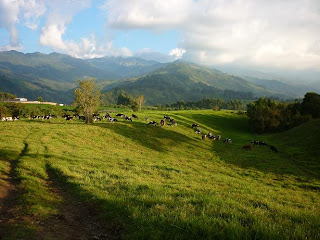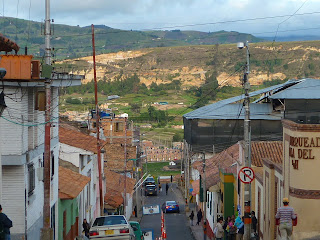My arrival in Bogotá was frought with misunderstanding. To start off with there was a problem with the pay as you go sim card, which delayed my departure from Tunja by 3 hours. Next, the sister of a friend of Aristide had offered me a place to stay, and we arranged to rendezvous at a point which I thought was close to the bus terminal, but actually on the outskirts of town. As I had no local knowledge, it would have meant going back through a traffic jam that the bus had taken 2 hours to negotiate, so in the end I elected to carry on into town by taxi and find a hostel. The terrible thing was that Marta was waiting for me for hours to show up, which I hadn't intended. The Candelária is the old section of Bogotá and a delightful place to wander around. Because it lies on the side of the cordillera, it is very reminiscent of Cape Town, with the mountains rising up behind with a cable way, although the similarity ends when you look the other way; the city sprawls through the middle of a valley and creeps up the hills on the other side, instead of beautiful ocean. It is filled with restaurants and museums, and on Friday evenig carrera Septima which runs from Plaza Bolívar is closed off to traffic and becomes a street market with live music and the most bizarre street theatre from singing midgets, to the best juggling group I've seen in ages, juggling fire clubs and knives from tall unicycles with a quivering audience member in the middle of the crossfire.One place I sadly missed out on was Casa de Citas; I had asked a Colombian staying in the same hostel in San Gil where to see live music in Bogotá and without hesitation he recommended Casa de Citas. When I mentioned this to the people I met in Tunja, they were both shocked and very amused. Apparently Casa de Citas is a euphemism for a brothel, a place to meet "artists" and they warned me about asking a taxi driver to take me there as I could get nto all sorts of unintended trouble. Conclusion: he must have been pulling my leg...So, I didn't even try. However, on my last Sunday, I went for a coffee with a woman who I started chatting to in a supermarket and I told her the story. She found it amusing, but told me that on the contrary, there is such a bona fide place, sadly only about 100m from where I was staying, and we walked there, and it is an upmarket restaurant hosting live performances only on the weekends.Que lástima!


There are a number of truly wonderful museums in Bogotá, with free entrance to many on a Sunday. My favourite was the Donación Botero, which has a fine collection of Boteros, European and North American art, as well as a section dealing with post conquest Colombian art, which evolved from being purely religious to secular and sophisticated; a very interesting journey to contemplate. Under the same roof is the Casa de la Moneda, which was originally the mint, but now is just part of the museum complex, and the evolution of coin and money is exhibited with examples from the barter system used by the indigenous who were apparently astute traders, to the introduction of paper currency. No punches are pulled in describing how the gold which had a spiritual rather than monetary value for the indigenous was initially purchased with a few beads or bits of mirror, to being forcefully stolen from homes, ransoming chiefs and grave robbing. The explanation was that the Spanish Crown had racked up huge debts in the reconquest of Spain as well as mounting the expiditions to the new world that creditors needed paying off. (It was also handy that they expelled the Jews from Spain and expropriated their property too) So as usual it seems that the f$@king bankers are to blame for creating havoc and distress in the world.The mint was created intially to manufacture the coin to pay taxes and levies to Spain. However, the one saving grace is that this museum along with the Gold Museum is the property of Banco de la Republica and they are great treasures for all to enjoy, although somewhat cynically one can't help wandering if they are useful tax dodge and an asset hedge against which they can do some dodgy lending elsewhere!

The view up the street in the Candelária looking towards the cordillera
The view across the courtyard at Donación Botero/ Casa de la Moneda

An interesting sculpture by Botero

A self portrait of the artist at work (Quite why he needed a model is beyond me.....)

A poignant work entitled "The letter" Although the distorted volume is Botero's trademark, I found it too much of a formula and couldn't find much beauty in the images. Rather the impact for me came from the humanity of these caractures.

Gold coins struck by Admiral Vernon to celebrate his conquest of Cartegena in 1740. Even though he had superior manpower (27 000) and firepower (3000 artillery pieces), he was repelled by the one eyed, one armed and one legged Blas de Lezo and failed to take the city. So these are curious tangible tokens of British hubris held at the Casa de la Moneda

View of Bogotá from the top of the cable way at Monserrate

The singing midget on Carrera Septima on a Friday evening
Maria who set me straight about Casa de Citas in the Plaza Bolívar Bogotá
The salt cathedral at Zipequira is touted as one of the wonders and unissable sights of modern Colombia. Although the photos came out reasonably well, I was was mostly unimpressed and unmoved by the cathedral made in the underground channels excavated by the mining of salt. It has stark modern abstract sculptures to represent the stations of the cross on the way down and a simple cross carved into the far wall of the main space. A copy of Micharlangelo's Creation from the Sistine chapel in marble compltes the cathedral. There are some of the usual gaudy Catholic icons and statues in a number of alcoves and the lady chapel, but these seem incongruent. More interesting is that the salt dome was once an evaporated sea bed millions (135?) of years ago, which was sandwiched by upthrust of the strata of the Andean cordillera. Underground streams leached out the salt, and the local indians recognising the salinity, wvaporated trays of it over fire to create salt loaves which they traded for a variety of goods with the other tribes in the Rio Magdalena valley.

One of the stations of the cross on the walk down into the main cavern
The cross carved into the wall behind the altar

The relief of the creation of Adam in the centre of the floor of the cathedral



































































